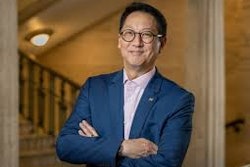There’s growing debate among educators on whether the umbrella Asian Pacific Islander label conceals disparities among Asian American students or provides political power in numbers.
Whenever Southeast Asian students meet with Channy Rasavong, they discuss a multitude of personal and schoolrelated topics. In fact, Rasavong and others credit such institutional assistance for the steady growth in Southeast Asian enrollment at the University of Wisconsin-Milwaukee.
*
But nationally, support services aimed at not only Southeast Asians but all Asian Pacific Islander students remain scarce in higher education, experts say, despite studies showing worrisome disparities among subgroups in degree attainment, retention and family income. Long-held social stereotypes and the popular but deceptive “model minority” myth have arguably lulled many U.S. college leaders into believing Asians across the board do not need outreach in order to succeed.
This mindset fuels a growing discussion among educators: Is the Asian Pacific Islander label appropriate for all of its subgroups? Does this label still benefit students or has it evolved into more of a hindrance? It depends who you ask. And, the variety of opinions illustrates not only the complexity of such a discussion, but also of the subgroups themselves.
“As a label, it may cover too much, too many different kinds of people,” says Dr. Mitchell Chang, professor of higher education and organizational change at the University of California, Los Angeles. “There are people lagging way behind other people who fall under this label.”
However, Ling-chi Wang, a longtime activist and associate professor emeritus of the University of California, Berkeley, says college students — even recent immigrants — still benefit from the Asian Pacific Islander umbrella more often than not. “There is a shared experience of what it means to be an Asian in America.”
Under the Statistics
A spectrum of distinct ethnicities falls under this country’s Asian Pacific Islander construct. The 2000 Census listed 24 categories for people of Asian descent and another 24 for those of Hawaii, Samoa and other Pacific islands. Yet generally, U.S. college students identify themselves on applications and other forms as Asian Pacific Islander, rather than by national origin.
Rasavong says the young people frequenting his UWM office — Southeast Asian American Student Services (SAASS) — consider themselves part of a broader landscape. About 90 percent of them are firstgeneration college-goers descended from refugees who fled communist regimes in 1975 or more recently.
“They consider this country their own,” says Rasavong, SAASS senior adviser. “In some ways, they’re more American than Asian. They hardly have a connection to Laos or other countries.”
Researchers say more college-backed offices such as SAASS — which provides career and academic counseling, financial aid advice and other referrals — are sorely needed throughout the country. While 64 percent of U.S. Asian Indians and 48 percent of Chinese hold a bachelor’s degree or higher, according to the census, barely 8 percent of U.S. Hmong and 8 percent of Laotians do.
“In terms of educational access and opportunity, some of the subgroups are having a tough time,” says Chang, a principal investigator of the 2007 report “Beyond Myths” that examined characteristics of Asian students over a multidecade period. He adds that well-intentioned efforts to improve graduation rates often are initiated by students themselves lack the resources and experience that university staff can — and should — provide.
Furthermore, the demographic variables within each Asian Pacific Islander subgroup, Chang and others say, merely underscore the need for institutional outreach to students.
Nationally, fewer than 14 percent of Chinese Americans, for instance, lived below the poverty line in 1999, according to census data. But in Brooklyn, N.Y., where 60 percent of Asians are Chinese, the median household income for Asians was less than $36,000. More than 42 percent of Asian adults lacked a high school diploma, while more than 40 percent age 17 or younger reported speaking English “less than very well.”
The 600 Southeast Asians attending UWM this past school year are about six times the number enrolled in the mid- 1990s, Rasavong says. As an undergraduate there at the time, he doesn’t remember Southeast Asians landing prestigious UWM scholarships. But in recent years, several Hmong have secured full tuition and room and board awards targeting the educationally disadvantaged.
Of UWM’s 123 Southeast Asian freshmen in the 2007 fall semester, about 66 percent continued their studies in spring 2008, Rasavong says, a figure that has held steady much of this decade. Without SAASS, that figure would likely run much lower, he and others say.
Divided We Fall
Some educators have no discomfort with the academy’s application of the Asian Pacific Islander label, but do question its core purpose.
“Why label me?” asks Dr. Rajib Sanyal, dean of Ball State University’s business college. “I’m not persuaded that calling me ‘Asian American’ is serving a specific goal to the work I’m doing.”
Born and raised in India, Sanyal has lived longer in this country than overseas. Among South Asian academicians he knows, hardly any of them feel overlooked or margi n a l i zed among a U.S. pan-Asian collective. “Nowadays, there are hardly any universities with no Indian faculty members. Even among Caucasian faculty, more and more of their mentors and advisers are foreign born.”
Yet amid this diversification of faculty, the stereotypes of Asian Pacific Islander students remain, such as the notion that the majority are entrenched in the Ivy League. In reality, 45 percent of Asians this past January attended two-year institutions, according to the American Association of Community Colleges. Their appeal is not new.
Nationally, more than 363,000 Asian Pacific Islanders enrolled at a community college in 2000 — more than at either public or private four-year schools, according to the National Center for Education Statistics. Between 1990 and 2000, Asian enrollment in two-year colleges jumped 73 percent.
Dr. Robert Teranishi, associate professor of higher education at New York University, says community colleges draw Asians for similar reasons they do other students — cheaper tuition and the flexibility to live at home while working to support family.
Political Power
As a principal investigator of the 2008 report “Facts, Not Fiction” that examined Asian student trends, Teranishi believes the Asian Pacific Islander label “has advantages and disadvantages” while noting “the label can help us negotiate things politically.” It is political activism that Asian educators are now harnessing in response to highly publicized, controversial changes in University of California admissions.
The changes, which UC officials have touted as ways to make more students eligible for UC, will result in admission increases as high as 10 percent for Whites, with Hispanics and Blacks picking up only 3 percent at best. But Asian admissions could fall by as much as 7 percent, according to UC projections. Among other changes affecting fall 2012 entering freshmen, UC will no longer require applicants to take SAT subject exams, which test knowledge, but instead will require only the SAT reasoning exam — one in which underrepresented minorities typically do not score high.
Wang, who criticizes the changes as “affirmative action for Whites,” says Asian educators, legislators and civil rights organizations are galvanizing grassroots support to try convincing UC officials to reconsider their plan. “We’re not dropping the ball.”
This type of activism causes Chang and others to stop short of suggesting that academia rename or even do away with the Asian Pacific Islander stamp because, collectively, they have more impact. “Labels are necessary for identifying and tracking discriminatory practices,” he says.
Meanwhile, he and others hope their efforts cause college leaders everywhere to rethink their assumptions about Asian students.
Plenty, they say, is at stake.
© Copyright 2005 by DiverseEducation.com


















